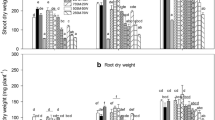Abstract
Maize (Zea mays var. Caldera) plants were grown under sterile and not sterile conditions in soil in an atmosphere continuously enriched with 14CO2 for 36 days. At harvest the above ground parts of the maize were cut off and the roots were separated from the soil by washing with water. The soil was dispersed using ultrasonics and separated into soluble clay silt and sand fraction. Roots were included in the coarse sand fraction. 25% of the total label present in the soil ≡ 5.5% of that in the soil-plant system, was water soluble. Very little label was present in the clay and silt fractions (5% in each) and most (65%) was in the sand fraction as root material.
Rapid extraction of soil after the removal of roots without ultrasonic treatment released soluble matter which amounted to <0.5% of the total activity in the soil-plant system.
Isolated roots steeped in water released about 18% of their activity. Much of the soluble fraction may therefore be root lysate.
The soil and roots accounted for 22% of the total activity in the soil-plant system. Glucose accounted for 89% of the sugars in the soluble fraction of the soil.
78% or more of the 14C present in glucose, arabinose and xylose constituents of the root-soil mixture occurred in the coarse and fine sand fractions, which also included root material. For mannose and galactose the value was 70% and for rhamnose, 50%.
After reinoculation of the soil-root mixture and decomposition for 56 weeks, the water soluble material obtained on fractionation of the soil decreased to less than 1% of the total activity. A much greater proportion, 25%, was present in the clay fraction as a result of decomposition.
Similar content being viewed by others
References
Barber D A and Martin J K 1976 The release of organic substances by cereal roots into soils. New Phytol. 76, 69–80.
Cheshire M V 1979 Nature and Origin of Carbohydrates in Soils. Academic Press, London.
Cheshire M V and Mundie C M 1981 The distribution of labelled sugars in soil particle size fractions as a means of distinguishing plant and microbial carbohydrate residues. J. Soil Sci. 32, 605–618.
Cheshire M V, Mundie C M and Shepherd H 1969 The origin of soil polysaccharide: Transformation of sugars during the decomposition in soil of plant material labelled with 14C. J. Soil Sci. 24, 54–68.
Glentworth R and Muir J W 1963 The soils of the country round Aberdeen, Inverurie and Fraserburgh. Memoirs of the Soil Survey of Scotland, Edinburgh. H.M.S.O.
Guckert A, Breisch H and Resinger O 1975 Interface sol-racine. I. Etude au microscope electronique des relations mucigelargile-microorganisms. Soil Biol. Biochem. 7, 241–250.
Helal H M and Sauerbeck D R 1983 Method to study turnover processes in soil layers of different proximity to roots. Soil Biol. Biochem. 15, 223–225.
Helal H M and Sauerbeck D R 1986 Effect of plant roots on carbon metabolism of soil microbial biomass. Z. Pflanzenernaehr. Bodenkd. 149, 181–188.
Martin J K 1977 Factors influencing the loss of organic carbon from wheat roots. Soil Biol. Biochem. 9, 1–7.
Merckx R, van Ginkel J H, Sinnaeve J and Cremers A 1986 Plant-induced changes in the rhizosphere of maize and wheat. I. Production and turnover of root-derived material in the rhizosphere of maize and wheat. Plant and Soil 96, 85–93.
Merckx R, Dijkstra A, den Hartog A and Veen J Avan 1987 Production of root-derived material and associated microbial growth in soil at different nutrient levels. Biol. Fertil. Soils 5, 126–132.
Mundie C M, Cheshire M V, Anderson H A and Inkson R H E 1976 Automated determination of monosaccharides using p-hydroxybenzoic acid hydrazide. Anal. Biochem. 71, 604–607.
Rovira A D 1969 Plant root exudates. Bot. Rev. 35, 35–57.
Samsevich S A 1965 Active excretions of plants roots and their significance. Sov. Pl. Phys. 12, 731–740 (English translation).
Sauerbeck D R and Johnen B 1976 The turnover of plant roots during the growth period and its influence on soil respiration. Z. Pflanzenernaehr. Bodenkd. 315–328.
Veen J AVan, Merckz R and Geijn S CVan de 1989 Plant- and soil-related controls of the flow of carbon from roots through the soil microbial biomass. Plant and Soil 115, 179–188.
Author information
Authors and Affiliations
Rights and permissions
About this article
Cite this article
Cheshire, M.V., Mundie, C.M. Organic matter contributed to soil by plant roots during the growth and decomposition of maize. Plant Soil 121, 107–114 (1990). https://doi.org/10.1007/BF00013103
Received:
Issue Date:
DOI: https://doi.org/10.1007/BF00013103




